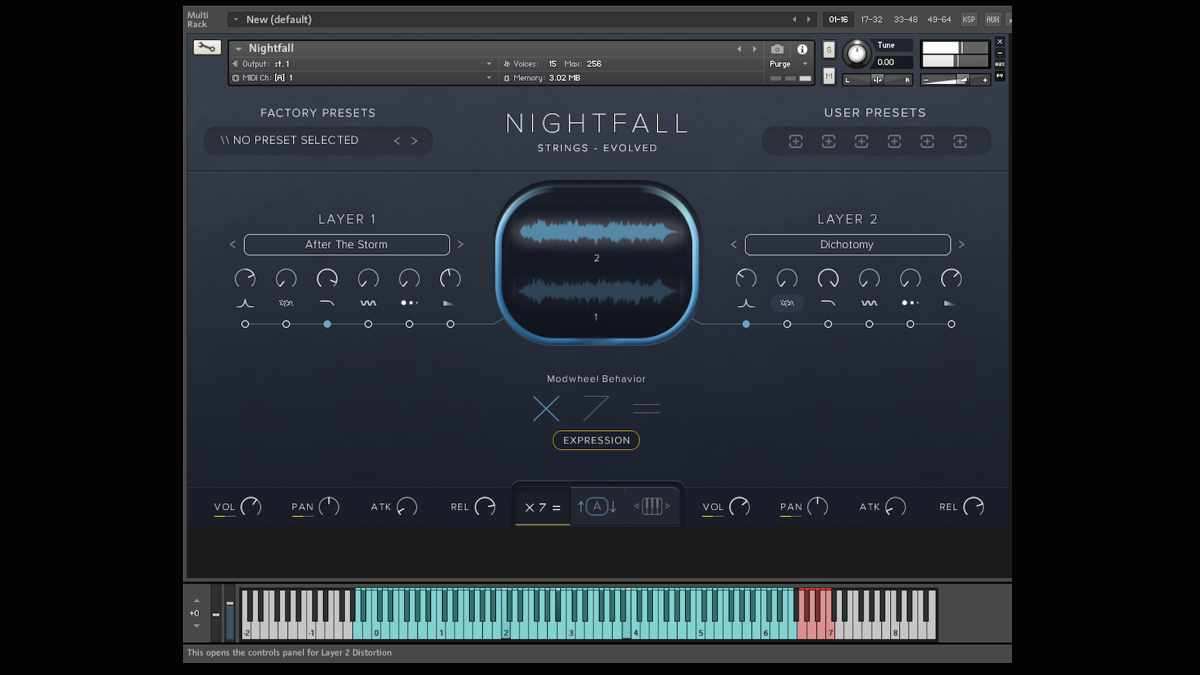In This Issue
Realitone Nightfall Hybrid/Organic Strings Library – the Synth and Software Review

Kays Al-Atrakchi calls it “One of the most exciting new products to come out in recent years.”
I can use many adjectives to describe Realitone sample developer Mike Greene, but predictable isn’t one of them. He first entered the sampling scene with a couple of folk/acoustic libraries (Realibanjo and Fingerpick), then tapped into pop and jazz vocal samples with Realivox Ladies and Blue, and then switched it up to urban rhythms with Hip Hop Creator.
Recently ago he subverted expectations once more by releasing Sunset Strings, one of the most versatile and useful strings libraries in recent times.
This year Mike continues to keep us on our toes with the release of the textural synth/orchestral strings hybrid instrument Nightfall.
Nightfall expertly blends previously recorded samples from Sunset Strings with pulsing synths and processed textures. The result yields a modern sound palette that seems perfect for those looking to produce scores that follow the recent trends.
Some of the material in this library is derived from Sunset Strings, but calling Nightfall an “expansion set” wouldn’t do it justice. All of the existing string samples have all been substantially processed and altered, lending a much more textural sonic character that is quite different from Sunset Strings. In addition, a great deal of new material ranging from synthetic ambiences to pulsing rhythms coupled with new features such as filters and automated parameters all contribute to make Nightfall feel like its own self-contained beast.
While the clean and intuitive user interface shares much DNA with Sunset Strings, it also adds a handful of very useful new features to allow for more customization and sonic mangling (more on that later).

Like Sunset Strings, each instrument is made up of two sample layers that can be combined and modulated in powerful ways. Large buttons in the middle of the UI choose between three modwheel behaviors: X means the bottom and top samples crossfade between each other, > means the top layer is progressively mixed with the bottom layer, or = means both layers sound simultaneously and the mod wheel acts as a crescendo/dynamics controller.

A welcome new addition is a Factory Presets drop-down menu. The presets are arranged in sub-categories such as Sustains, Combos, Textures, Rhythms, etc., which makes finding the desired preset quite easy. In addition, names such as Stranger Thing, Caffeinated, and Galloping Thunder offer useful stylistic hints that further help narrow down the search.

Six User Preset slots let you save custom sets, although I found myself wishing for the ability to save my presets in a similar drop-down menu system along with custom names.
Nightfall introduces a very powerful effect and filtering system visualized as a set of six dials for each layer. The effects that can be enabled individually consist of a Tone Shaper (a notch EQ), Distortion, Hi/Low Pass Filter, Motion (an amplitude modulator with selectable waveforms), Delay, and Reverb.
Clicking on each effect icon reveals additional controls, as well as the ability to link the amount of effect to the mod wheel and a control curve to fine tune how much of the effect is applied when the mod wheel is turned. Of course, this being Native Instruments Kontakt sampler, right-clicking on any parameter lets you assign to it custom real-time MIDI CC controls.

Another handy new feature is the Automatic Modwheel option, a continuous sweeping modulation between the two layers that runs automatically, driven by either the host DAW’s tempo or by a user-customizable speed value.
I was interested in testing Nightfall on a scoring project I’m currently working on. The goal was to give my cues an unusual textural character, as well as adding rhythmic motion without necessarily having to resort to standard percussion.
I pulled up the preset Find A Way, which has a strong synth pulse to provide a rhythmic base for my track. Next, I added a shimmering high end with the preset Inner Peace, which I tweaked a bit by adding some distortion that I modulated inversely to the Mod Wheel position.
To accentuate the downbeats with a simple staccato pattern, I used the Giga Staccs preset in which I enabled the Automatic Modwheel to give subtle variations to the repeating ostinato pattern. Lastly, I added a series of melodic accents using the preset Slow Rain with some additional delay and distortion added for good measure.
The end result was an unusual mix of timbres and sonorities that gave my cue a truly unique feel that I don’t think I could have easily achieved with other libraries.
For being such a deep and complex sample library, I found using Nightfall to be incredibly intuitive, musical, and creatively satisfying. The addition of curated Presets provides such a useful set of creative starting points that I hope Mike Greene will consider adding them to Sunset Strings as well.
Nightfall’s ability to conjure up unsettling ambiences, pulsating synths that sound downright massive, and vast textural landscapes makes this library one of the most exciting new products to come out in recent years.
NI Native Access download, 7.46 GB installed (stereo lossless NCW format)
Works on Windows and Mac (Windows 7 and up / Mac OS 10.13 High Sierra or higher)
Works in the free Kontakt Player 6.2.2 or higher
Price: $129 (introductory, may go up to $199
















